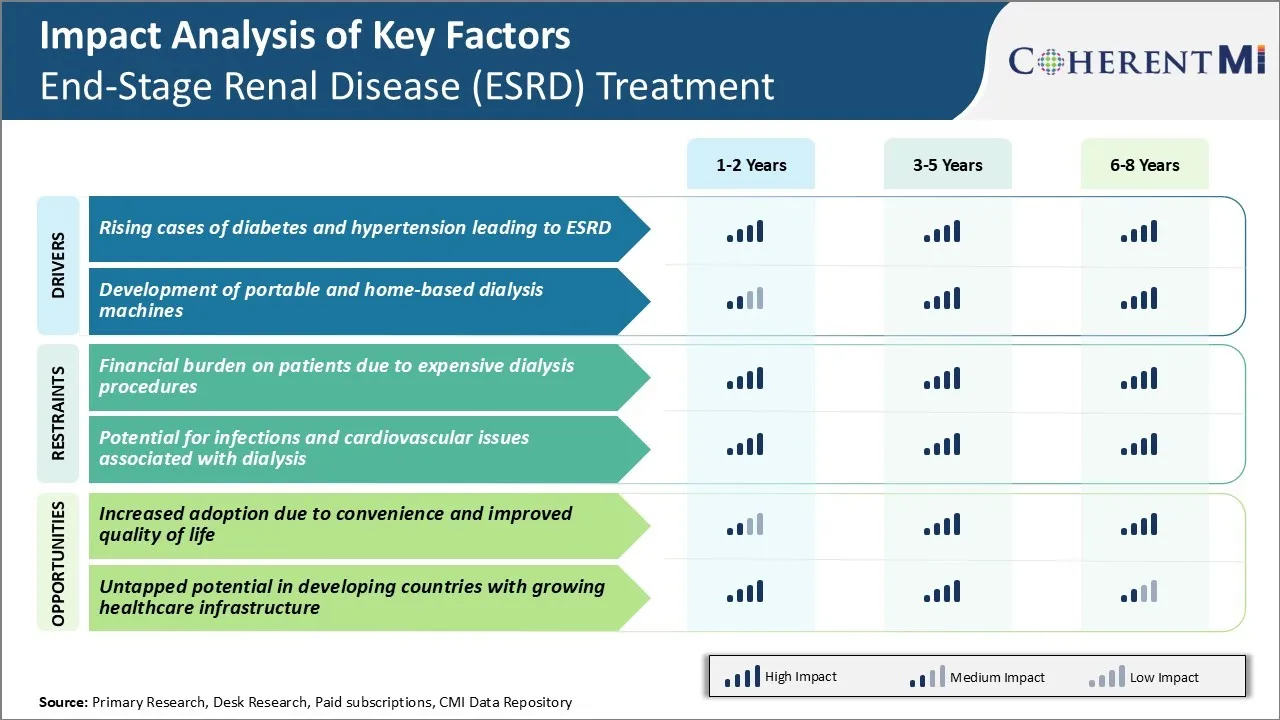End-Stage Renal Disease (ESRD) Treatment Market Trends
Market Driver - Rising Cases of Diabetes and Hypertension Leading to ESRD
The cases of diabetes and hypertension have been rising significantly all over the world in the past few decades. Both diabetes and hypertension are known risk factors that can eventually lead to end-stage renal disease if not managed properly. According to studies and reports from healthcare organizations, over 30% of new ESRD patients develop the condition due to complications of diabetes and another 30% due to hypertension.
If not treated on time through medications and lifestyle changes, diabetes can deteriorate into ESRD where dialysis or kidney transplant is needed for survival. Likewise, long-term uncontrolled high blood pressure strains the blood filtering units within the kidneys called nephrons. Hypertension causes the nephrons to thicken and narrow over time restricting the blood flow within the kidneys. As a result, the kidney function declines abruptly leading to end-stage renal failure.
Both diabetes and hypertension have grown into epidemics in the recent past primarily due to sedentary lifestyles and unhealthy eating habits across populations. Unless aggressive steps are taken to control these conditions, it is likely that ESRD cases attributed to them will continue rising rapidly thereby driving the end-stage renal disease (ESRD) treatment market.
Market Driver - Development of Portable and Home-based Dialysis Machines
Traditionally, dialysis treatment meant traveling to a hospital or clinic thrice a week to undergo hemodialysis procedures that lasted 3-4 hours each time. This posed major inconvenience and affected quality of life of ESRD patients significantly. However, with advances in dialysis machine technology, alternate renal replacement therapies are becoming available that offer greater portability and flexibility for patients.
Newer lightweight and compact machines allow home and portable hemodialysis to be administered more frequently but for shorter durations. Instead of visiting hospitals thrice a week for long hours, patients can hook up to a dialysis machine at home for short sessions even daily or nocturnal dialysis.
Similarly, home-based peritoneal dialysis offers periodic fluid exchanges using embedded catheters for continuous internal cleansing of fluids and wastes through the peritoneum. Low-profile machines have automated the process minimizing hands-on time and enabling independent living. Such developments have boosted patient compliance towards renal replacement therapies and quality of life. As more options emerge in home and portable care, it has driven the demands in the ESRD treatment market away from traditional hospital-centric models towards more patient-centric solutions. This shift is expected to continue shaping trends and strengthening overall growth prospects in the end-stage renal disease (ESRD) treatment market.

Market Challenge - Financial Burden on Patients Due to Expensive Dialysis Procedures
One of the major challenges faced by the end-stage renal disease (ESRD) treatment market is the high financial burden dialysis procedures place on patients. Dialysis is an expensive procedure that needs to be conducted either at dialysis centers or at home multiple times per week. The average cost of dialysis per patient annually in the US is estimated to be around $88,000.
While some of this cost is covered by public and private insurance, patients still have to bear significant out-of-pocket expenses. This poses severe financial hardship on many ESRD patients who are often retired or unable to work. The high treatment costs sometimes force patients to discontinue their care or undergo fewer sessions than required. This can negatively impact their health outcomes.
The costs of medications, transportation to dialysis centers, and incidental expenses also add to the financial strain on patients. Addressing this issue through measures like expanding insurance coverage, improving reimbursement rates, and reducing treatment costs is important to drive greater accessibility and adherence to ESRD care.
Market Opportunity - Increased Adoption Due to Convenience and Improved Quality of Life
One major opportunity for the ESRD treatment market lies in increased adoption of home dialysis solutions like peritoneal dialysis. Home dialysis therapies offer ESRD patients’ greater convenience and flexibility compared to in-center hemodialysis, as they can undergo treatment in the comfort of their own homes according to their schedules. This improves patients' quality of life by reducing hospital visits and allowing them to lead more normal lives.
Home therapies have also been associated with better clinical outcomes. With technological advancements making home machines safer and easier to use, more patients are opting for home dialysis. This reduces the burden on dialysis centers while offering lifestyle benefits. Increased education around home therapies and expansion of support programs can help boost their adoption rates further. This presents a substantial growth opportunity for suppliers of home dialysis products and services within the end-stage renal disease (ESRD) treatment market.